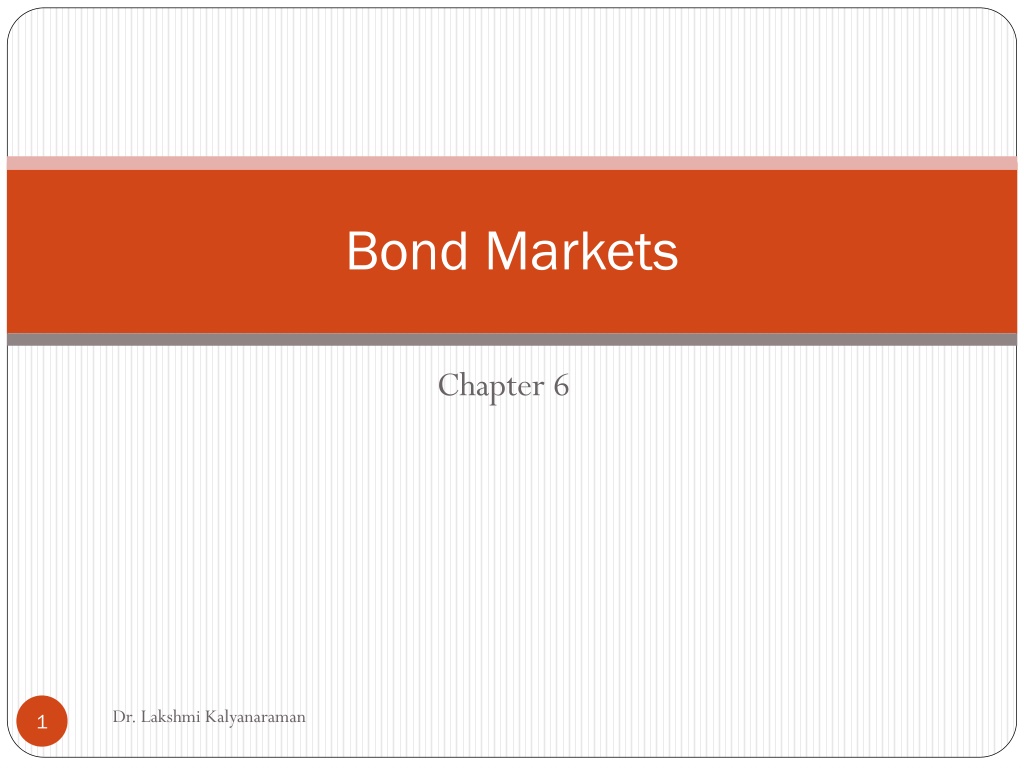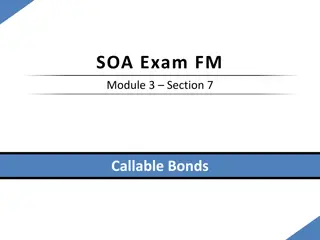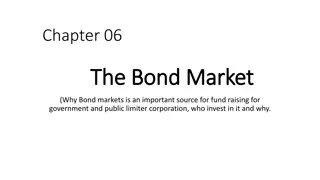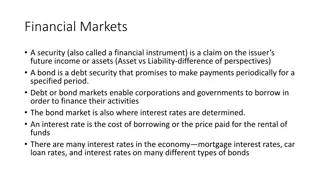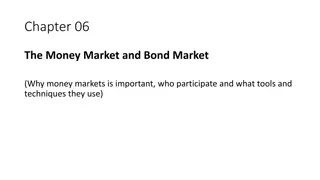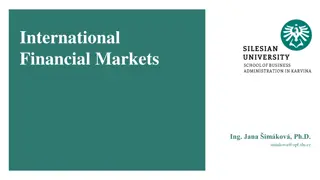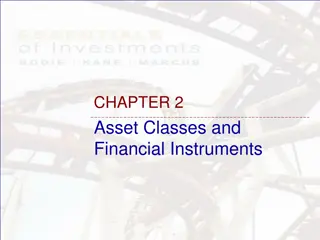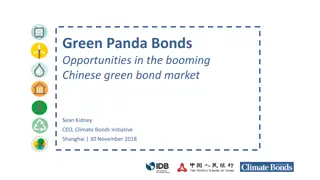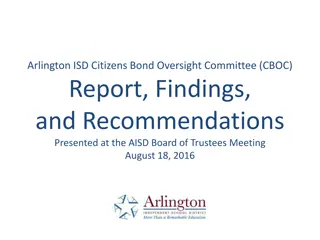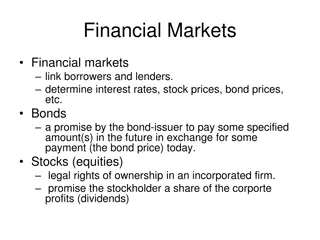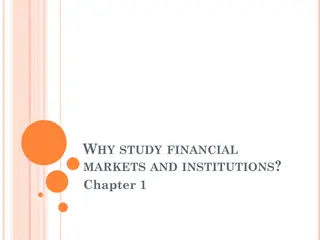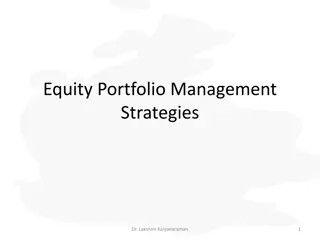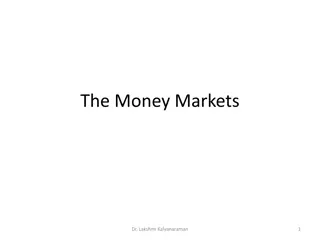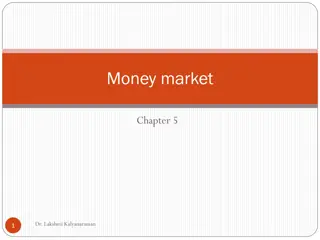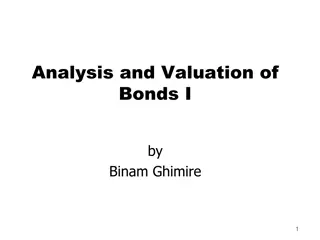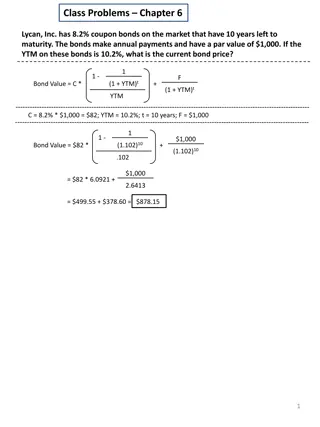Understanding Bond Markets: Insights from Dr. Lakshmi Kalyanaraman
Explore the world of bond markets through Dr. Lakshmi Kalyanaraman's perspective. Learn about bond instruments, issuers, market classifications, and associated risks. Discover the dynamics of Treasury notes and bonds in financing national debt and their unique characteristics such as default risk, interest rate fluctuations, and liquidity concerns.
Download Presentation

Please find below an Image/Link to download the presentation.
The content on the website is provided AS IS for your information and personal use only. It may not be sold, licensed, or shared on other websites without obtaining consent from the author. Download presentation by click this link. If you encounter any issues during the download, it is possible that the publisher has removed the file from their server.
E N D
Presentation Transcript
Bond Markets Chapter 6 Dr. Lakshmi Kalyanaraman 1
Bond and bond markets Equity (stocks) and debt (notes, bonds and mortgages) instruments with maturities of more than one year trade in capital markets. Dr. Lakshmi Kalyanaraman 2
Bonds Long-term debt obligations Issued by corporations and government Dr. Lakshmi Kalyanaraman 3
Bonds Bond issuers promise to pay a specified amount in the future on maturity of the bond (the face value) + Coupon interest on the borrowed funds If terms not met by the bond issuer, bond investor has a claim on the assets of the bond issuer Dr. Lakshmi Kalyanaraman 4
Bond markets Bonds are issued and traded Classified into 1. Treasury notes and bonds 2. Municipal bonds 3. Corporate bonds Dr. Lakshmi Kalyanaraman 5
Bond market securities Dr. Lakshmi Kalyanaraman 6
Treasury notes and bonds Issued by the government To finance national debt National debt reflects the historical accumulation of annual federal government deficit or expenditures (G) minus taxes (T) over the last 200-plus years. Dr. Lakshmi Kalyanaraman 7
Treasury notes and bonds N = ( ) ND G T t t t = 1 t Dr. Lakshmi Kalyanaraman 8
Treasury notes and bonds Default risk free: backed by the full faith and credit of the govt. Low returns: low interest rates (yields to maturity) reflect low default risk Interest rate risk: because of their long maturity, T-notes and T-bonds experience wider price fluctuations than money market securities when interest rates change Liquidity risk: older issued T-bonds and T-notes trade less frequently than newly issued T-bonds and T-notes Dr. Lakshmi Kalyanaraman 9
Treasury notes and bonds T-notes have original maturities from over 1 to 10 years T-bonds have original maturities from over 10 years Issued in minimum denominations (multiples) of $1,000 May be either fixed principal or inflation-indexed Dr. Lakshmi Kalyanaraman 10
Treasury notes and bonds inflation-indexed bonds are called Treasury Inflation Protection Securities (TIPS) Principal value of TIPS is adjusted by the percentage change in the Consumer Price Index (CPI) every six months Trade in very active secondary markets Dr. Lakshmi Kalyanaraman 11
Treasury STRIPS Separate Trading of Registered Interest and Principal Securities (STRIPS), a.k.a. Treasury zero bonds or Treasury zero-coupon bonds Financial institutions and government securities brokers and dealers create STRIPS from T-notes and T-bonds Dr. Lakshmi Kalyanaraman 12
Treasury STRIPS STRIPS have the periodic interest payments separated from each other and from the principal payment one set of securities reflects interest payments one set of securities reflects principal payments STRIPS are used to immunize against interest rate risk Dr. Lakshmi Kalyanaraman 13
Treasury Notes and Bond yields 1 1 [1+?? 2]^?? ?? 2 ??=(INT/M) [ ] Where Vb = Present value of the bond M = Face value of the bond INT = Annual interest payment N = Number of years till maturity m = Number of times per year interest is paid rb = Interest rate used to discount cash flows on the bond Dr. Lakshmi Kalyanaraman 14
Accrued interest When an investor buys T-note or T-bond between coupon payments, the buyer must compensate the seller that portion of the coupon payment accrued between last coupon payment and the settlement date. Settlement takes place 1 to 2 days after a trade. Dr. Lakshmi Kalyanaraman 15
Accrued interest That portion of the coupon payment accrued between the last coupon payment and the settlement day Actual number of days since last coupon payment =INT Accrued interest 2 Actual number of days in coupon period Dr. Lakshmi Kalyanaraman 16
Treasury Notes and Bonds The full (or dirty) price of a T-note or T-bond is the sum of the clean price (Vb) and the accrued interest Dr. Lakshmi Kalyanaraman 17
Municipal bonds Municipal bonds (Munis) are securities issued by state and local governments to fund imbalances between expenditures and receipts to finance long-term capital outlays Attractive to household investors because interest is exempt from federal and most local income taxes General obligation (GO) bonds are backed by the full faith and credit of the issuing municipality Revenue bonds are sold to finance specific revenue generating projects Dr. Lakshmi Kalyanaraman 18
Municipal Bonds Compare Muni returns with fully taxable corporate bonds by finding the after tax return for corporate bonds: ia= ib(1 t) ia = after-tax rate of return on a taxable corporate bond ib = before-tax rate of return on a taxable bond t = marginal total income tax rate of the bond holder Alternately, convert Muni interest rates to tax equivalent rates of return: ib= ia/(1 t) Dr. Lakshmi Kalyanaraman 19
Municipal Bonds Primary markets Firm commitment underwriting: Issue of securities by an investment bank Investment bank guarantees the issuer a price for newly issued securities by buying the whole issue at a fixed price from the issuer It then seeks to resell these securities to suppliers of funds (investors) at a higher price Dr. Lakshmi Kalyanaraman 20
Municipal Bonds Best efforts underwriting: Issue of securities in which the investment bank does not guarantee a price to the issuer and Acts more as a placing or distribution agent on a fee basis related to its success in placing the issue Dr. Lakshmi Kalyanaraman 21
Municipal Bonds Private placement: A security placed with one or few large institutional buyers Dr. Lakshmi Kalyanaraman 22
Municipal Bonds Secondary markets: Munis trade infrequently due mainly to a lack of information on bond issuers Dr. Lakshmi Kalyanaraman 23
Corporate Bonds Corporate bonds are long-term bonds issued by corporations Bond indenture: Legal contract that specifies the rights and obligations of the bond issuer and the bond holder Dr. Lakshmi Kalyanaraman 24
Corporate bonds Bond characteristics Dr. Lakshmi Kalyanaraman 25
Bearer versus Registered bonds Bearer bonds: Bonds with coupons attached to the bond. Holder presents the coupons to the issuer for payments of interest when they come due. Registered Bond: A bond in which the owner is recorded by the issuer and the coupon payments are mailed to the registered owner. Dr. Lakshmi Kalyanaraman 26
Term versus Serial bonds Term Bond: Entire issue matures on a single date. Serial bonds: issue contains many maturity dates, with a portion of the issue being issue being paid off on each date. For economic reasons, many issuers like to avoid a crisis at maturity . Dr. Lakshmi Kalyanaraman 27
Mortgage bonds Bonds issued to finance specific projects, which are pledged as collateral for the bond issue. Bond holders may legally take title to the collateral to obtain payment on the bonds if the issuer of the mortgage bond defaults Equipment trust certificates are bonds collateralized with tangible movable non-real estate property such as railcars and airplanes. Dr. Lakshmi Kalyanaraman 28
Debentures Bonds backed solely by the general credit worthiness of the issuing firm, unsecured by specific assets or collateral. Dr. Lakshmi Kalyanaraman 29
Subordinated debentures Bonds that are unsecured and are junior in their rights to mortgage bonds and regular debentures. Dr. Lakshmi Kalyanaraman 30
Convertible bonds Bonds that may be exchanged for another security of the issuing firm at the discretion of the bond holder. Dr. Lakshmi Kalyanaraman 31
Corporate Bonds Convertible bonds versus non-convertible bonds = cvb i ncvb i op cvb icvb = rate of return on a convertible bond incvb = rate of return on a nonconvertible bond opcvb = value of the conversion option Stock warrants give bondholders the opportunity to purchase common stock at a pre-specified price Dr. Lakshmi Kalyanaraman 32
Corporate Bonds Callable bonds versus non-callable bonds i = i op ncb cb cvb incb = rate of return on a noncallable bond icb = rate of return on a callable bond opcvb = value of the call option A Sinking fund provision is a requirement that the issuer retire a certain amount of the bond issue early as the bonds approach maturity Dr. Lakshmi Kalyanaraman 33
Corporate Bonds Primary markets are identical to that of Munis Secondary markets the exchange market the over-the-counter (OTC) market Bond ratings bonds are rated by perceived default risk bonds may be either investment or speculative (i.e., junk) grade Dr. Lakshmi Kalyanaraman 34
Bond Market Indexes Reflect both the monthly capital gain and loss on bonds plus any interest (coupon) income earned Changes in values of bond indexes can be used by bond traders to evaluate changes in the investment attractiveness of bonds of different types and maturities Dr. Lakshmi Kalyanaraman 35
Bond Market Participants The major issuers of debt market securities are federal, state and local governments, and corporations The major purchasers of capital market securities are households, businesses, government units, and foreign investors businesses and financial firms (e.g., banks, insurance companies, and mutual funds) are the major suppliers of funds for Munis and corporate bonds foreign investors and governments are the major suppliers of funds for T-notes and T-bonds Dr. Lakshmi Kalyanaraman 36
International Bonds and Markets International bond markets involve unregistered bonds that are internationally syndicated, offered simultaneously to investors in several countries, and issued outside of the jurisdiction of any single country Eurobonds are long-term bonds issued outside the country of the currency in which they are denominated Foreign Bonds are long-term bonds issued outside of the issuer s home country Brady Bonds are bonds swapped for an outstanding loan to a less developed country Sovereign Bonds are Brady Bonds that have had their underlying collateral removed and the creditworthiness of the country is substituted instead Dr. Lakshmi Kalyanaraman 37
